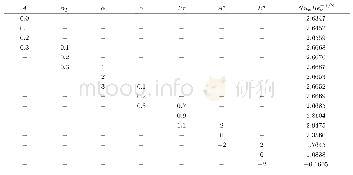《Table 7Computational mesh sensitivity for finding peak pressure during wedge drop》
 提示:宽带有限、当前游客访问压缩模式
提示:宽带有限、当前游客访问压缩模式
本系列图表出处文件名:随高清版一同展现
《排水型船外飘砰击和甲板淹湿的经验估算方法(英文)》
Mesh sensitivity study is performed for 15°wedge.In case of 2D wedge drop simulations,pressure at the bottom-most point of the wedge is of relevance;hence,the same is measured for various mesh counts in sensitivity study.Table 7shows the measured peak pressure for various mesh counts.It can be observed that pressure varies only by 0.3%by increasing the mesh count from 0.8 M to 1.2 M,i.e.,increasing mesh count beyond 0.8 M has insignificant effect on peak pressure.Computational time is also noted in Table 7.Computations were performed on a 60-core machine(×3650HPC server).It can be observed that the computational time increases by almost 60%with the mesh count increase from0.5 M to 0.8 M.Further increase of approximately 55%in computational time is noted for mesh count of 1.2 M.Thus total mesh count of 0.8 M is used for numerical simulation of15°wedge considering insignificant change in computed peak pressure and considerably higher computational time for increased mesh count.For other wedges,i.e.,25°and 30°,total mesh count of nearly 1 M is used.The mesh count was increased for higher wedge angle based on the increase in width and depth of the wedge model used.Meshing strategy with overset mesh and refinement around the wedge and at the waterline to capture the swell was used for the computation.The computational mesh is shown in Fig.17.The time step of2e-4 s is chosen so as to not miss out on the accuracy in capturing the swell-up with Courant number of less than 1maintained in each case.
| 图表编号 | XD0024731000 严禁用于非法目的 |
|---|---|
| 绘制时间 | 2018.09.25 |
| 作者 | Sharad Dhavalikar、Prasada N.Dabbi、Deepti Poojari、Ramkumar Joga、Sachin Awasare |
| 绘制单位 | Research and Innovation Centre, Indian Register of Shipping、Research and Innovation Centre, Indian Register of Shipping、Research and Innovation Centre, Indian Register of Shipping、Research and Innovation Centre, Indian Register of Shipping、Research and In |
| 更多格式 | 高清、无水印(增值服务) |
查看“Table 7Computational mesh sensitivity for finding peak pressure during wedge drop”的人还看了
-

- 表4 不同共聚物压敏胶的压敏性测试结果Tab.4 Determination results for pressure sensitivity of different copolymer pressure-sensitive adhesi





